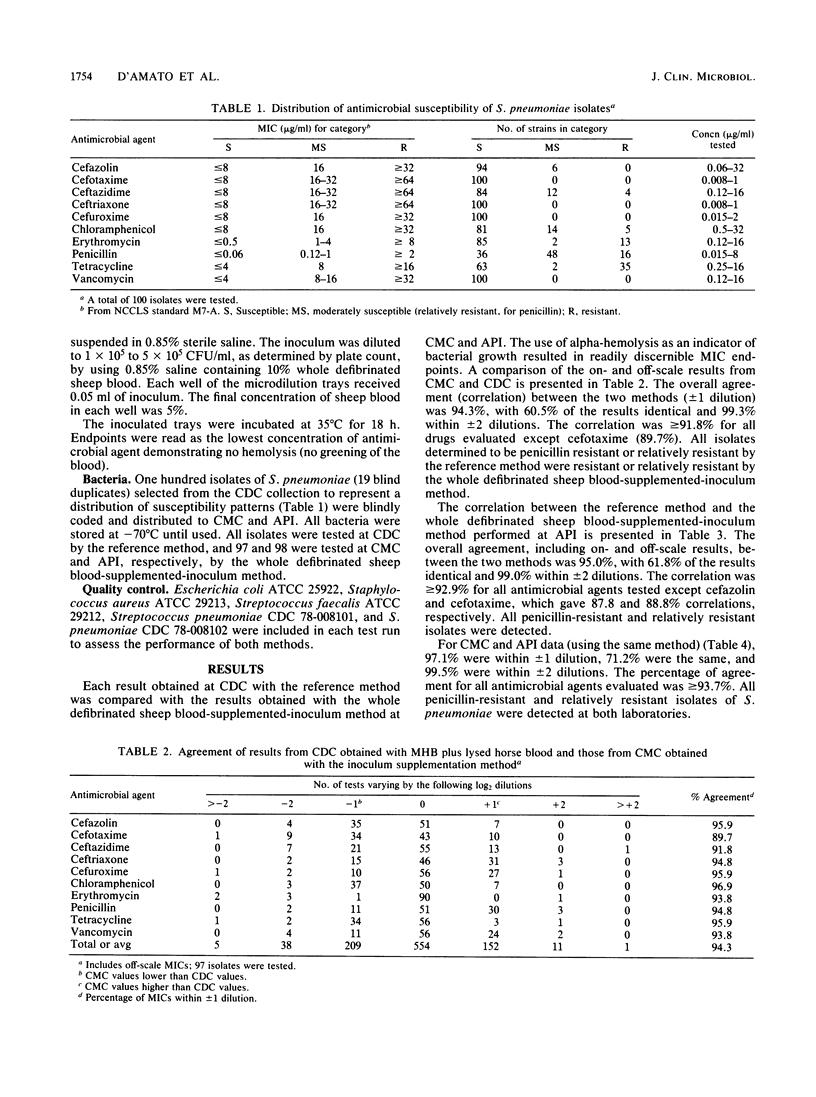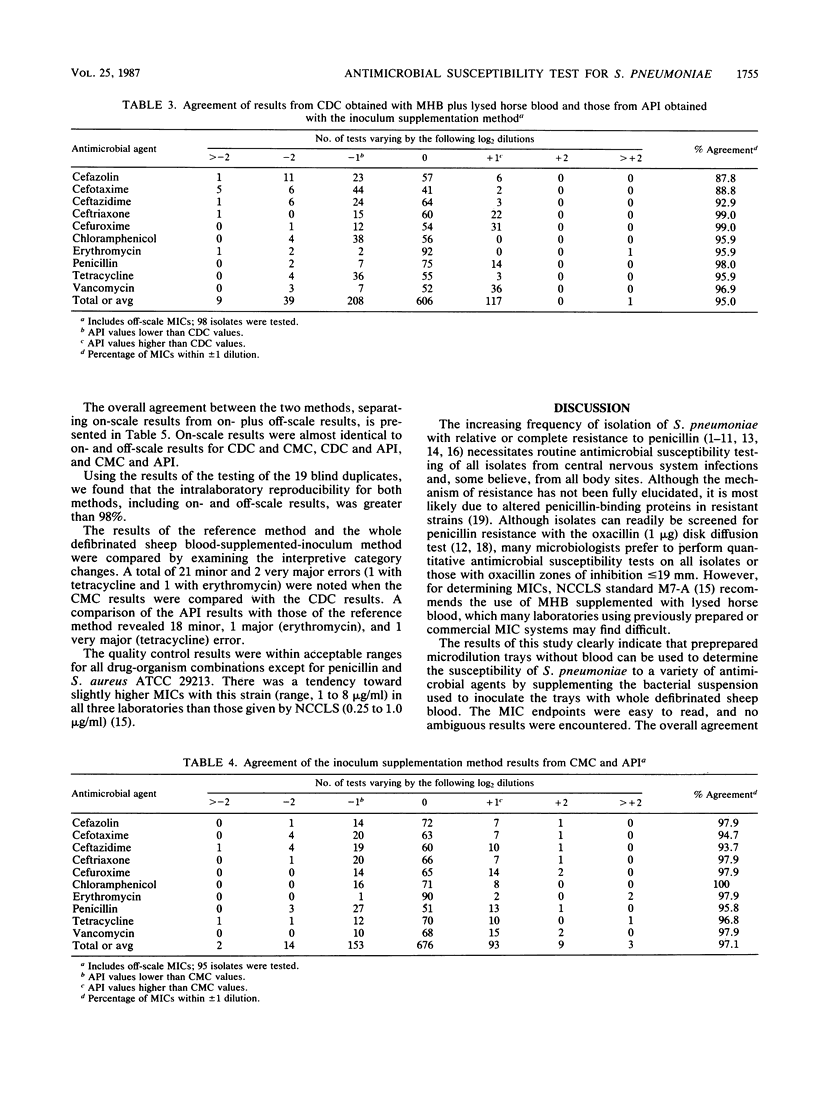Abstract
The National Committee for Clinical Laboratory Standards recommends the use of lysed horse blood-supplemented Mueller-Hinton broth for determining the quantitative antimicrobial susceptibility of Streptococcus pneumoniae. This procedure may be difficult for laboratories using previously prepared or commercial MIC systems. Therefore, a study was undertaken to determine whether previously prepared microdilution trays containing Mueller-Hinton broth without blood could be used for determining the antimicrobial susceptibility of S. pneumoniae by adding whole defibrinated sheep blood to the bacterial suspension used to inoculate the trays. The presence of alpha-hemolysis was used as an indicator of bacterial growth. One hundred isolates of S. pneumoniae selected to represent a distribution of susceptibility patterns were tested by the National Committee for Clinical Laboratory Standards method and the sheep blood-supplemented-inoculum method. Greater than 94% agreement between the two methods was achieved. The sheep-blood-supplemented-inoculum procedure was highly reproducible and easy to perform and provides an acceptable alternative for determining the MICs for S. pneumoniae for laboratories using previously prepared or commercial microdilution systems.
Full text
PDF



Selected References
These references are in PubMed. This may not be the complete list of references from this article.
- Appelbaum P. C., Bhamjee A., Scragg J. N., Hallett A. F., Bowen A. J., Cooper R. C. Streptococcus pneumoniae resistant to penicillin and chloramphenicol. Lancet. 1977 Nov 12;2(8046):995–997. doi: 10.1016/s0140-6736(77)92892-6. [DOI] [PubMed] [Google Scholar]
- Cates K. L., Gerrard J. M., Giebink G. S., Lund M. E., Bleeker E. Z., Lau S., O'Leary M. C., Krivit W., Quie P. G. A penicillin-resistant pneumococcus. J Pediatr. 1978 Oct;93(4):624–626. doi: 10.1016/s0022-3476(78)80901-9. [DOI] [PubMed] [Google Scholar]
- Dajani A. S. Antibiotic-resistant pneumococci. Pediatr Infect Dis. 1982 May-Jun;1(3):143–144. doi: 10.1097/00006454-198205000-00001. [DOI] [PubMed] [Google Scholar]
- Dixon J. M. Letter: Pneumococcus with increased resistance to penicillin. Lancet. 1974 Aug 24;2(7878):474–474. doi: 10.1016/s0140-6736(74)91865-0. [DOI] [PubMed] [Google Scholar]
- Feldman C., Kallenbach J. M., Miller S. D., Thorburn J. R., Koornhof H. J. Community-acquired pneumonia due to penicillin-resistant pneumococci. N Engl J Med. 1985 Sep 5;313(10):615–617. doi: 10.1056/NEJM198509053131006. [DOI] [PubMed] [Google Scholar]
- Hansman D., Glasgow H., Sturt J., Devitt L., Douglas R. Increased resistance to penicillin of pneumococci isolated from man. N Engl J Med. 1971 Jan 28;284(4):175–177. doi: 10.1056/NEJM197101282840403. [DOI] [PubMed] [Google Scholar]
- Istre G. R., Humphreys J. T., Albrecht K. D., Thornsberry C., Swenson J. M., Hopkins R. S. Chloramphenicol and penicillin resistance in pneumococci isolated from blood and cerebrospinal fluid: a prevalence study in metropolitan Denver. J Clin Microbiol. 1983 Mar;17(3):472–475. doi: 10.1128/jcm.17.3.472-475.1983. [DOI] [PMC free article] [PubMed] [Google Scholar]
- Jackson M. A., Shelton S., Nelson J. D., McCracken G. H., Jr Relatively penicillin-resistant pneumococcal infections in pediatric patients. Pediatr Infect Dis. 1984 Mar-Apr;3(2):129–132. doi: 10.1097/00006454-198403000-00010. [DOI] [PubMed] [Google Scholar]
- Jacobs M. R., Gaspar M. N., Robins-Browne R. M., Koornhof H. J. Antimicrobial susceptibility testing of pneumococci. 2. Determination of optimal disc diffusion test for detection of penicillin G resistance. J Antimicrob Chemother. 1980 Jan;6(1):53–64. doi: 10.1093/jac/6.1.53. [DOI] [PubMed] [Google Scholar]
- Jacobs M. R., Koornhof H. J., Robins-Browne R. M., Stevenson C. M., Vermaak Z. A., Freiman I., Miller G. B., Witcomb M. A., Isaäcson M., Ward J. I. Emergence of multiply resistant pneumococci. N Engl J Med. 1978 Oct 5;299(14):735–740. doi: 10.1056/NEJM197810052991402. [DOI] [PubMed] [Google Scholar]
- Krause K. L., Stager C., Gentry L. O. Prevalence of penicillin-resistant pneumococci in Houston, Texas. Am J Clin Pathol. 1982 Feb;77(2):210–213. doi: 10.1093/ajcp/77.2.210. [DOI] [PubMed] [Google Scholar]
- Liñares J., Garau J., Domínguez C., Pérez J. L. Antibiotic resistance and serotypes of Streptococcus pneumoniae from patients with community-acquired pneumococcal disease. Antimicrob Agents Chemother. 1983 Apr;23(4):545–547. doi: 10.1128/aac.23.4.545. [DOI] [PMC free article] [PubMed] [Google Scholar]
- Tarpay M. M., Welch D. F., Marks M. I. Antimicrobial susceptibility testing of Streptococcus pneumoniae by micro-broth dilution. Antimicrob Agents Chemother. 1980 Oct;18(4):579–581. doi: 10.1128/aac.18.4.579. [DOI] [PMC free article] [PubMed] [Google Scholar]
- Zighelboim S., Tomasz A. Penicillin-binding proteins of multiply antibiotic-resistant South African strains of Streptococcus pneumoniae. Antimicrob Agents Chemother. 1980 Mar;17(3):434–442. doi: 10.1128/aac.17.3.434. [DOI] [PMC free article] [PubMed] [Google Scholar]


